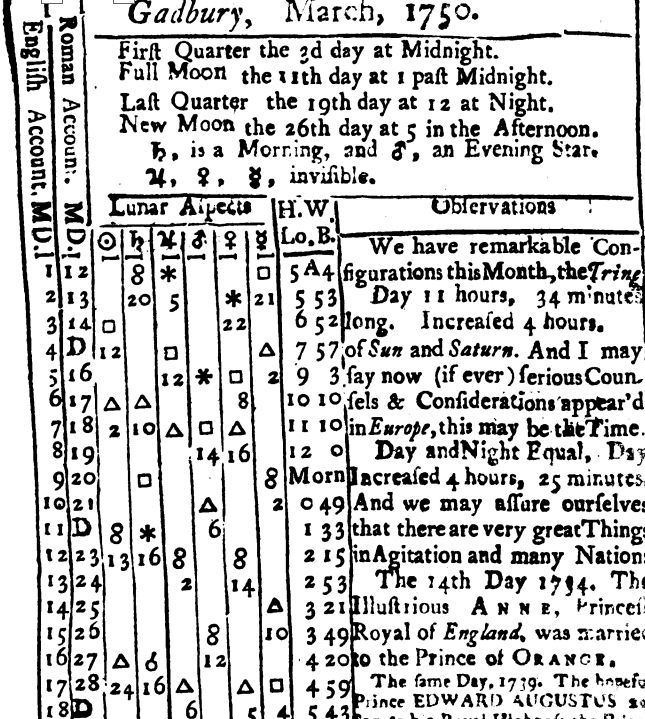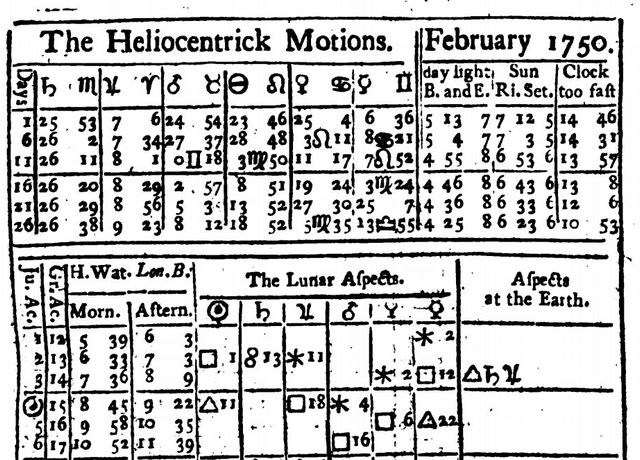Friday, January 01, 2021
Calendrical diversity
Got curious about the old English habit of starting the new year on March 25. It was still common in 1750, and continued in the colonies as well. Dates between Jan 1 and Mar 24 were often listed with both years.
This didn't seem to bother anyone.
Looking it up, I found a much broader range of calendrical diversity, an easy handling of two or more systems at once. We've lost this form of diversity along with all others. In all areas of "life", EXACTLY ONE FORM OF THOUGHT IS POSSIBLE.
From a 1750 Collection of Almanacs:
 Best of all, the almanacs treated heliocentric and geocentric astronomy on an equal footing, which is exactly where they belong. We have decided with our usual insane ferocity that the geocentric version is HERESY.
Best of all, the almanacs treated heliocentric and geocentric astronomy on an equal footing, which is exactly where they belong. We have decided with our usual insane ferocity that the geocentric version is HERESY.

 Typesetters in shops that printed almanacs were amazingly talented! All of those astrological symbols, plus horizontal and vertical text, plus red and black text alternating in some places, requiring two separate forms with precise registration for each page.
In addition, most of the almanacs had mathematical sections with queries from readers answered by hugely complex formulas. Lots of integrals and square roots and Greeks and superscripts.
Continued in next item.
Typesetters in shops that printed almanacs were amazingly talented! All of those astrological symbols, plus horizontal and vertical text, plus red and black text alternating in some places, requiring two separate forms with precise registration for each page.
In addition, most of the almanacs had mathematical sections with queries from readers answered by hugely complex formulas. Lots of integrals and square roots and Greeks and superscripts.
Continued in next item.
It is also well worthy of Notice that though in our Almanacks according to an Old (but not very commendable) Custom, we begin the Year with the first of January; that is not in Reality our New-years-day but the 25th of March: That being supposed to be the Day of our Saviours Incarnation, and by some asserted (tho’ Erroniously) the Day also of the Vernal Equinox at that time; But tho' this be a Mistake it is certain beyond Contradiction that this very day was the first Day of the Jewish Month Nisan; if the Vulgar Era of Christ, be the true Era, which is very strenuously contended for by diverse Learned Historians and Chronologers, and is therefore not with out Reason both by the Ecclesiastical and Civil Laws of this Realm accounted the Beginning of the Year. Consequently a Note, Bond, or any other Writing Executed in this Year according to our Almanacks before Lady-Day and dated 1749 (should any dispute arise about it in some future Year) will not be adjudged by the Law to take place before that time Twelve-Month.I can't unravel the punctuation and syntax, but it seems to be saying that March 25 is the proper date both religiously and legally. A 1921 listing of Bank Holidays in various countries and states shows a different form of diversity. Dixie still observed Confederate holidays officially, with banks closed. Russia in 1921 was still in transition from Orthodox to Soviet, with the Orthodox holidays and Julian calendar still dominant.
January 7-8 Christmas Holidays (O.S.) January 14 New Year's Day (O.S.) March 11 Anniversary of the Revolution April 7 Good Friday (O.S.) April 8 Holy Saturday (O.S.) April 10 Easter Monday (O.S.) April 11 Tuesday after Easter (O.S.) May 14 International Labor Day (O.S.) May 18 Ascension Day (O.S.) August 28 Assumption (O.S.) September 27 Exaltation of the Cross (O.S.) October 25 Bolshevist Revolution (N.S.) According to article 11 of the Eight Hour Law, all of the above dates are enumerated as holidays on which work is stopped, together with all Sundays. By the consent of the majority of workmen of an establishment or industry, or a part of them, the holidays of January 1 and 6, August 15, September 14, December 26, Saturday of Passion Week, and Easter Monday may be replaced by other free days. The Government of the People's Commissioners issued a decree adopting the Gregorian calendar as from February 14, 1918, but this does not appear to have affected the dates on which holidays are observed, as these still follow the calendar of the Greek Church according to the first available information.Thailand managed to observe everyone's holidays at once!
January 1 King's Birthday February 8 Chinese New Year (1st Day) February 9 Chinese New Year (2nd Day) February 10 Chinese New Year (3rd Day) March 25 Good Friday March 26 Holy Saturday March 28 Easter Monday April 1 Siamese Official New Year May 16 Whit Monday May 24 Victoria Day June 3 Birthday of King George V July 1 Half Year Holiday July 14 Fête Nationale of France August 1 Bank Holiday December 2 Coronation of King of Siam December 25 Christmas Day December 26 Boxing DayBritish religious, British official, French official, Chinese official, and Thai official. Note that the official New Year was April 1. Thailand still uses its own calendar and its own years more than the external world's years. Along with the Lady Day vs New Year mapping, Julian and Gregorian were both active, and the almanacs kept track of both. English Account = Julian, Roman Account = Gregorian.
 Best of all, the almanacs treated heliocentric and geocentric astronomy on an equal footing, which is exactly where they belong. We have decided with our usual insane ferocity that the geocentric version is HERESY.
Best of all, the almanacs treated heliocentric and geocentric astronomy on an equal footing, which is exactly where they belong. We have decided with our usual insane ferocity that the geocentric version is HERESY.

 Typesetters in shops that printed almanacs were amazingly talented! All of those astrological symbols, plus horizontal and vertical text, plus red and black text alternating in some places, requiring two separate forms with precise registration for each page.
In addition, most of the almanacs had mathematical sections with queries from readers answered by hugely complex formulas. Lots of integrals and square roots and Greeks and superscripts.
Continued in next item.
Typesetters in shops that printed almanacs were amazingly talented! All of those astrological symbols, plus horizontal and vertical text, plus red and black text alternating in some places, requiring two separate forms with precise registration for each page.
In addition, most of the almanacs had mathematical sections with queries from readers answered by hugely complex formulas. Lots of integrals and square roots and Greeks and superscripts.
Continued in next item.Labels: Metrology
